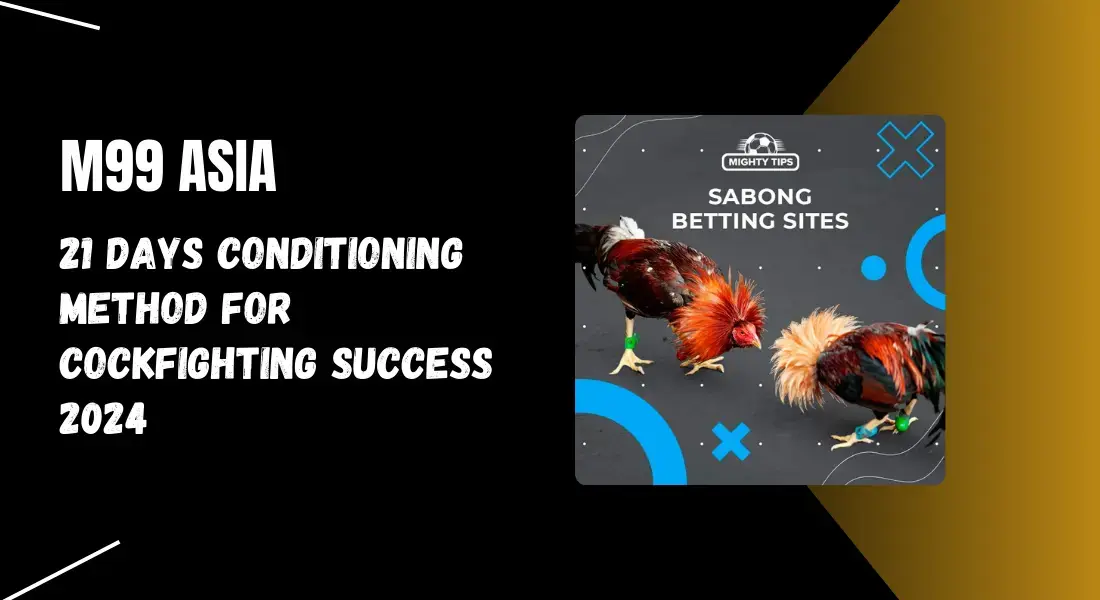Cockfighting requires a well-trained rooster and a well-prepared conditioning routine that ensures the gamefowl is at its peak during the fight. The 21 Days Conditioning Method is widely used to bring out the best in your fighting cock, focusing on physical fitness, agility, health, and combat readiness. This step-by-step guide can enhance your bird’s chances of success in the arena.
Ready to join the action? Sign up now and get your welcome bonus! New players can enjoy a 100% match bonus on their first deposit plus 50 free spins.

Pre-Conditioning Stage
Before the rigorous 21-day conditioning phase, it’s your crucial responsibility to evaluate the physical characteristics of your fighting cock. This pre-conditioning stage involves assessing the bird’s health status, including its strength, alertness, weight, and overall appearance, to ensure it’s ready for the upcoming training.
A healthy fighting cock should have:
- Strong Legs: For mobility and delivering powerful strikes.
- Bright Eyes: Indicative of alertness and readiness to react quickly.
- Well-Developed Plumage: Feathers should be glossy and intact, showing that the bird is well-nourished.
- High Energy Levels: The cock should exhibit aggressive behavior, be active, and show no signs of lethargy or illness.
Once the bird is in top physical shape, you can proceed to the 21-day conditioning phase. You can also check on how to choose the best cockfighter on sabong.
Pre-Conditioning Stage
The conditioning method is divided into daily activities designed to optimize the bird’s strength, stamina, and combat instincts. Each day focuses on specific aspects of the bird’s health and training.
Day 1: Deworming (Pagpupurga)
The first day is dedicated to deworming to remove internal parasites like roundworms, tapeworms, and other harmful organisms that can drain the bird’s energy and affect its performance. Proper deworming ensures the bird starts training with a clean system, allowing maximum nutrient absorption and vitality.
Tip: Use a vet-recommended dewormer and ensure that the dosage is correct for the weight and age of the cock.
Day 2: Bacterial Flushing and Injection
On Day 2, the focus is on bacterial flushing, where the bird is given medications or natural treatments to remove harmful bacteria from its system. This is essential to prevent infections during the intensive training period. An antibiotic injection may also be administered to boost the bird’s immune system and guard against diseases that could hinder its conditioning.
Tip: Consult a veterinarian for the appropriate antibiotic to ensure the bird’s immune system is in top shape.
Day 3: Rotation Day and Administration of Injectables
On Day 3, rotation exercises begin. These exercises improve the bird’s mobility, leg strength, and balance. The rotation involves light running, jumping, and using a rotating perch to mimic the movements needed in a fight. Additionally, injectables like multivitamins and immune boosters are administered to support overall health.
Tip: Use multivitamins that include a mix of B vitamins, amino acids, and minerals to promote muscle growth and recovery.
Day 4: Rotation Day and First Sparring Day
Sparring is introduced on Day 4 after the rotation exercises. Sparring sessions are crucial for sharpening the bird’s reflexes and combat instincts. Light sparring avoids injury while allowing the bird to practice its striking techniques and learn how to defend itself.
Tip: Control sparring sessions and avoid overexertion. It’s about sharpening skills, not exhausting the bird.
Day 5 to Day 7: Rotation Days
From Day 5 to Day 7, the bird continues with rotation exercises. These days are about building stamina and ensuring the bird maintains its strength throughout the training period. The rotation exercises involve running, jumping, and light flight exercises to improve endurance and agility.
Tip: Monitor the bird’s energy levels and adjust the intensity of exercises if necessary.
Day 8: Rest Day
On Day 8, a complete rest day is provided to the bird. This rest day is not a break from the training, but a crucial component of the regimen. It allows the bird’s muscles to recover from the previous week of training, preventing overtraining and ensuring the bird retains its energy for later stages.
Tip: Provide proper hydration and nutrition on rest days to facilitate muscle recovery and energy replenishment.
Day 9 to Day 11: Rotation Days
The next phase of rotation exercises runs from Day 9 to Day 11, similar to the first week but with increased intensity. These exercises build endurance and help maintain muscle tone without overstressing the bird. The goal is to ensure the bird maintains a good balance of strength and agility.
Tip: Gradually increase the difficulty of the exercises to push the bird to its optimal performance without overburdening it.
Day 12: Rest Day
On Day 12, another rest day is introduced. Rest days are critical in a training regimen as they allow the bird’s body to heal and recover from the cumulative physical effort.
Tip: Observe the bird closely during rest days to ensure no signs of injury or fatigue.
Day 13 to Day 15: Rotation Days
The intensity of the rotation exercises should reach its peak from Day 13 to Day 15. These days, focus on maintaining strength, balance, and sharp reflexes. The exercises are similar to previous days but should challenge the bird’s stamina and agility.
Tip: Rotate exercises to target different muscle groups and maintain the bird’s interest in training.
Day 16: Rest Day
Day 16 is another rest day, ensuring the bird can recover after intense exercise. By this time, the bird’s endurance and strength should be nearing their peak.
Tip: Provide nutritious food and supplements to boost the bird’s energy during this recovery day.
Day 17 to Day 19: Rotation Days
The final set of rotation exercises occurs from Day 17 to Day 19. These days are crucial as the bird will operate at its highest conditioning level. The rotation exercises focus on speed, precision, and balance, preparing the bird for actual combat.
Tip: Monitor the bird’s energy and overall health to ensure it’s ready for the fight.
Day 20: Rest Day
The final rest day on Day 20 is all about recovery before the big day. The bird is allowed to rest completely to preserve its energy and readiness.
Tip: To ensure the bird is in the best condition for the fight, keep it relaxed and in a stress-free environment.
Day 21: Final Rotation and Selection
On Day 21, the bird undergoes its final rotation session to fine-tune its reflexes, balance, and agility. After this final session, the bird is selected based on weight, energy levels, combat readiness, and overall health.
Tip: The bird should display heightened alertness, aggressive behavior, and physical readiness for combat.
You can now bet on Live Sabong at M99 Asia!
Conclusion
The 21 Days Conditioning Method is essential for preparing your gamefowl for cockfighting success. By following the daily steps for deworming, rotation exercises, sparring, and rest, you can ensure your rooster reaches its peak performance by Day 21. With proper care and attention to detail, this method will maximize your bird’s potential in the ring, giving you the best chance for victory at M99 Asia.
Related Topic: Where to Bet on Sabong Online?
FAQs
Why is deworming essential for gamefowl conditioning?
Deworming removes internal parasites, which can drain energy and nutrients from the bird, making it less effective in training and during fights. A parasite-free bird has better stamina and nutrient absorption.
How often should sparring be incorporated into the conditioning method?
Sparring should be introduced early in training but used sparingly to avoid injuries. Light sparring on specific days helps sharpen combat skills and builds the bird’s confidence without overexerting it.
Can I skip rest days in the 21-day conditioning method?
No, rest days are crucial for recovery. Overtraining without rest can lead to exhaustion, muscle breakdown, and reduced performance in the arena. Rest allows the bird’s muscles to repair and its energy levels to replenish.
What injectables should be used during the conditioning phase?
Common injectables include multivitamins, amino acids, and immune boosters. These injections strengthen the bird’s immune system, promote faster muscle recovery, and increase stamina. Always consult a veterinarian for proper administration.
How do I know if my rooster is ready for the fight?
A rooster ready for a fight should exhibit high energy, alertness, and aggressive behavior during sparring. It should also have excellent muscle tone, quick reflexes, and a healthy weight. A final assessment on Day 21 ensures the bird is in peak condition.
M99 Asia Login Khmer
M99 Asia Login Khmer providing reliable information about M99 Asia! Sign up at M99 Asia and claim your Welcome bonus!





